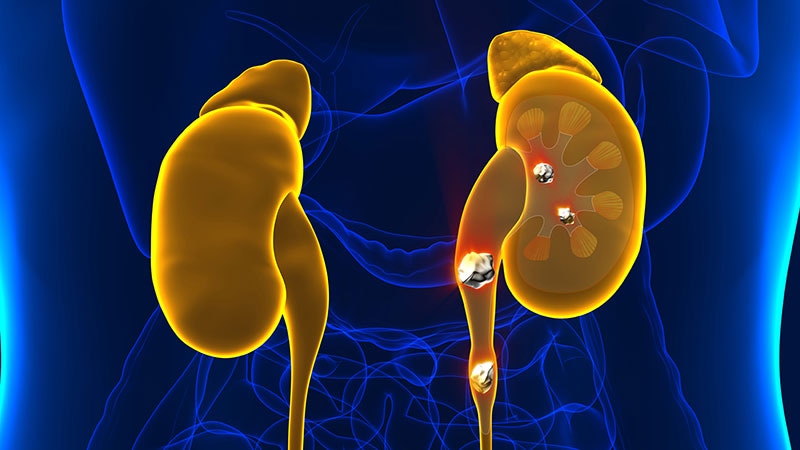Active Surveillance for Asymptomatic Kidney Stones Study Results
Core Concepts
Active surveillance is a viable option for asymptomatic kidney stones.
Abstract
Dr. Kevin Stritt presented findings at the American Urological Association (AUA) 2023 Annual Meeting regarding the natural history of asymptomatic renal stones. The NOSTONE trial assessed the efficacy of hydrochlorothiazide in preventing recurrence in patients with recurrent calcium-containing kidney stones. Key points include:
39% of kidney stone passages were asymptomatic.
Asymptomatic stones were a median size of 2.4 mm.
Patients with stones less than 2 mm have a high chance of passing them in about 8 days.
Urologists can consider active surveillance for small stones but may opt for more aggressive management for larger stones.
Dehydration and specific diets contribute to the increasing incidence of kidney stones.
Patients with a history of stones have a high risk of recurrence.
Watching Feasible for Asymptomatic Kidney Stones
Stats
"39% (158) were asymptomatic stone passages" - Dr. Kevin Stritt
"52% are likely to develop symptoms" - Dr. Ephrem Olweny
"Patients with a history of stones have a 50% risk of recurrence in the next 5 years" - Dr. David Schulsinger
Quotes
"Observation should be initially offered to these patients. However, patients should be informed that 52% are likely to develop symptoms, and some may indeed opt for pre-emptive surgical removal." - Dr. Ephrem Olweny
"But if a patient has a 7- or 8-mm stone, you might be more inclined to manage that patient a little bit more aggressively." - Dr. David Schulsinger
Key Insights Distilled From
by Howard Wolin... at www.medscape.com 04-28-2023
https://www.medscape.com/viewarticle/991251
Deeper Inquiries
How can the findings of this study impact the current approach to managing kidney stones?
The findings of this study can significantly impact the current approach to managing kidney stones by providing valuable insights into the natural history of asymptomatic renal stones. The data from the NOSTONE trial suggest that a substantial number of kidney stones pass spontaneously without symptoms, highlighting the potential for active surveillance in select patients. This information can lead to a shift towards a more conservative management approach for asymptomatic kidney stones, reducing the need for immediate surgical intervention and potentially avoiding unnecessary procedures. Urologists can now feel more comfortable monitoring small stones, particularly those averaging 2.4 mm or less in size, and offer observation as an initial option to patients with asymptomatic stones.
What are the potential drawbacks of relying on active surveillance for asymptomatic kidney stones?
While active surveillance for asymptomatic kidney stones can be a viable management strategy in many cases, there are potential drawbacks to consider. One significant concern is the risk of symptomatic progression in patients under observation. As noted in the study, over half of patients with asymptomatic stones are likely to develop symptoms, which may necessitate more aggressive treatment measures. Additionally, there is a possibility of complications arising from untreated stones, such as infection or obstruction, which could lead to more severe health issues if not addressed promptly. Furthermore, the psychological burden of living with the uncertainty of when or if a stone will become symptomatic may impact the quality of life for some patients. Therefore, careful patient selection and regular monitoring are essential to mitigate these risks when opting for active surveillance.
How can the study's results influence patient education and decision-making regarding kidney stone treatment?
The study's results can play a crucial role in patient education and decision-making regarding kidney stone treatment by providing evidence-based information on the management of asymptomatic stones. Patients diagnosed with asymptomatic renal stones can benefit from understanding the likelihood of spontaneous passage without symptoms and the option of active surveillance as a conservative approach. By educating patients about the findings of this study, healthcare providers can empower individuals to make informed decisions about their treatment plan. Patients may feel more confident in choosing observation over immediate intervention for small stones, knowing that it is a safe and effective strategy in many cases. Additionally, discussing the potential risks and benefits of active surveillance versus early intervention can help patients weigh their options and participate in shared decision-making with their healthcare team. Ultimately, the study's results can enhance patient awareness, engagement, and satisfaction with their kidney stone management plan.
0
